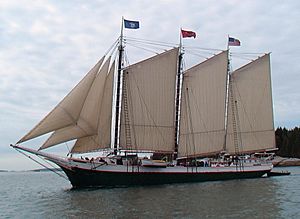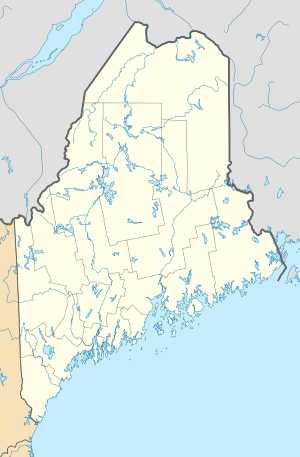Victory Chimes (schooner) facts for kids
 |
|
| History | |
|---|---|
| Name |
|
| Builder | George K. Phillips Co., Bethel, Delaware; J.M.C. Moore, designer |
| Launched | April 1900 |
| Homeport | Rockland, Maine |
| Identification | Official number 136784 |
| General characteristics | |
| Type | Chesapeake Ram schooner |
| Tonnage | 208 tons (gross), 178 tons (net) |
| Length | 127.5 ft (38.9 m) |
| Beam | 23.8 ft (7.3 m) |
| Draft |
|
| Propulsion | 210 hp (160 kW) Cummins diesel (2010) |
| Sail plan | Three masted Gaff rigged schooner |
| Speed | 7 knots (13 km/h; 8.1 mph) |
| Complement | 9 crew members, 50 guests |
|
Victory Chimes
|
|
| Location | Rockland, Maine |
| Built | 1900 |
| Architect | J.M.C.Moore |
| NRHP reference No. | 93000637 |
| Significant dates | |
| Added to NRHP | 24 June 1996 |
| Designated NHL | 25 September 1997 |
The Victory Chimes is a very special ship! It's a three-masted schooner, which means it has three tall masts and uses sails to move. This amazing ship is also known by its older names, Edwin and Maud and Domino Effect. It's so important that it's been named a US National Historic Landmark. This means it's a place or object that is historically very important to the United States. The Victory Chimes is the last surviving "Chesapeake Ram schooner" of its kind. You can even see a ship that looks like the Victory Chimes on the Maine State Quarter coin!
Contents
Building the Victory Chimes
The Victory Chimes was built in 1900. It was made in Bethel, Delaware, by a company called George K. Phillips Co. Its first name was Edwin and Maud. This name came from the children of its first captain, Robert E. Riggen.
How the Ship Was Designed
The ship was designed to carry cargo. It moved goods around the Chesapeake Bay. It had a special design called a "ram" rig. This rig included several sails: a standing jib, flying jib, staysail, foresail, mainsail, and spanker (or mizzen). The top parts of the main sails were held up by poles called gaffs. The bottom parts were tied to booms.
The ship was built with a centerboard. This is a large, flat board that can be lowered into the water. It helps the ship stay stable and sail better. When the centerboard is up, the ship needs only 7 feet 6 inches of water. When it's down, it needs 18 feet of water. This shallow design was perfect for working in the Chesapeake Bay.
The Ship's Journey
The Edwin and Maud worked as a cargo ship until 1945. It carried things like wood, grain, coal, and fertilizer. In 1946, it was changed to carry passengers instead of cargo.
New Name, New Adventures
In 1954, a group of people bought the ship. They renamed it Victory Chimes. They used it for special trips in Maine. Later, in 1984, a banker named Jerry Jubie bought the ship. He paid about $1 million for it. He took it to Duluth, Minnesota. There, it was used for educational trips for high school students.
The ship was sold again in 1987. Then, in 1988, Thomas Monaghan bought it. He was the owner of Domino's Pizza. He changed the ship's name to Domino Effect. He used the ship for trips to reward his employees. He spent a lot of money to fix it up. He wanted to make it look like it did when it was first built. The ship came back to Maine in 1989.
Back to Victory Chimes
In 1990, Captain Kip Files and Captain Paul DeGaeta bought the ship. They wanted to use it for passenger trips. They changed its name back to Victory Chimes. In 1997, the ship was still sailing without an engine.
The Victory Chimes uses a special small boat to help it move. This boat is called a yawlboat. It pushes against the back of the schooner. When it's not being used, it's towed behind the ship. The current yawlboat was built in 1991. It has a 135 horsepower Ford diesel engine. This helps the Victory Chimes compete with other passenger ships that have engines. As of 2010, the yawlboat, named Enoch, had a 210 HP Cummins diesel engine. The ship also has a small engine from 1904. It's a 6 horsepower Seeger engine. This engine helps pull up the anchors and can help raise the sails.
A National Treasure
The Victory Chimes was added to the National Register of Historic Places in 1996. This is a list of places and objects that are important to American history. In 1997, it was given an even higher honor. It was named a National Historic Landmark. This shows how truly special and important the Victory Chimes is to the history of the United States.


